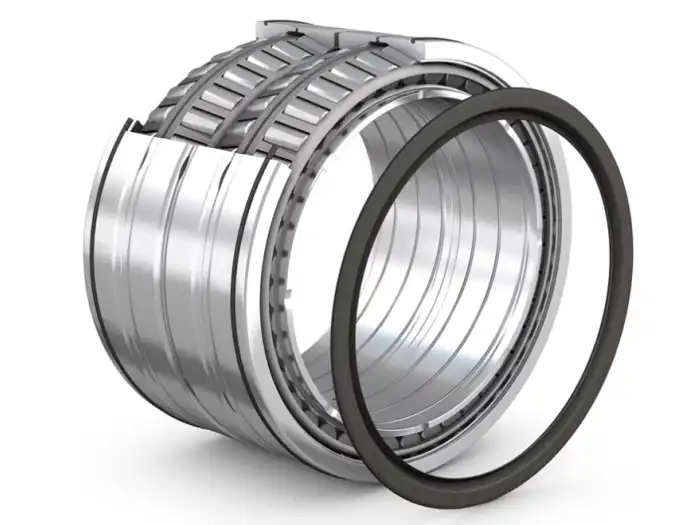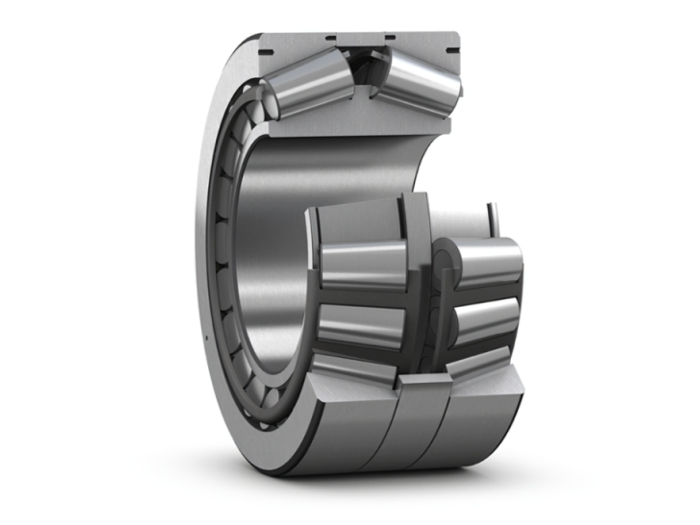How Do Conical Bearings Manage Combined Loads?
Conical bearings, also known as tapered roller bearings, are remarkable engineering components designed to handle complex load scenarios in various industrial applications. These specialized bearings excel in managing combined loads, which consist of both radial and axial forces acting simultaneously on a rotating shaft or component. The unique geometry of conical bearings, featuring tapered rollers arranged between two raceways, allows them to distribute loads effectively across a larger contact area. This design not only enhances their load-bearing capacity but also improves their ability to maintain proper alignment under demanding conditions. As industries continue to push the boundaries of machinery performance, conical bearings play a crucial role in ensuring smooth, efficient, and reliable operation in equipment ranging from automotive transmissions to heavy industrial machinery. Their ability to manage combined loads makes them indispensable in applications where traditional bearings might fall short, offering engineers and designers a versatile solution for complex mechanical systems.

What Are the Key Design Features of Conical Bearings?
Tapered Geometry and Load Distribution
The hallmark of conical bearings is their tapered geometry, which is fundamental to their ability to manage combined loads effectively. The inner and outer raceways, along with the rollers, are all tapered at specific angles. This design allows the bearing to distribute both radial and axial loads across a larger contact area, reducing stress concentrations and enhancing overall load-bearing capacity. The tapered rollers are precisely engineered to maintain optimal contact with the raceways under various load conditions, ensuring smooth rotation and minimizing friction. This unique geometry also enables conical bearings to self-align to a certain extent, compensating for minor misalignments in the shaft or housing. The careful selection of taper angles is crucial, as it directly influences the bearing's performance characteristics, including its ability to handle different ratios of radial to axial loads.
Material Selection and Heat Treatment
The performance of conical bearings heavily relies on the materials used in their construction and the subsequent heat treatment processes. High-quality alloy steels, such as chrome steel or case-hardened steel, are commonly employed to manufacture the rings and rollers of conical bearings. These materials are chosen for their excellent wear resistance, high strength, and ability to maintain dimensional stability under varying temperatures and loads. The heat treatment process, typically involving carburizing or through-hardening, further enhances the bearing components' surface hardness and core toughness. This combination of material properties and heat treatment ensures that conical bearings can withstand the high stresses associated with combined loads, resist wear and fatigue, and maintain their precision over extended periods of operation. The careful selection of materials and heat treatment processes contributes significantly to the bearing's overall performance and longevity in managing combined loads.
Cage Design and Lubrication Considerations
The cage in a conical bearing plays a crucial role in maintaining proper roller spacing and orientation, which is essential for managing combined loads effectively. Cages are typically made from materials like brass, steel, or high-performance polymers, each offering specific advantages in terms of strength, weight, and friction characteristics. The design of the cage must allow for adequate lubrication flow while ensuring that the rollers remain properly guided throughout their rotation. Lubrication is particularly critical in conical bearings due to the sliding contact between the roller ends and the rib of the inner ring. Proper lubrication helps minimize friction, dissipate heat, and prevent wear, all of which are crucial for the bearing's ability to handle combined loads efficiently. Advanced cage designs may incorporate features that enhance lubricant retention and distribution, further improving the bearing's performance and longevity under demanding load conditions.

How Do Conical Bearings Compare to Other Bearing Types in Managing Combined Loads?
Load Capacity and Efficiency
Conical bearings exhibit superior performance in managing combined loads compared to many other bearing types. Their tapered design allows them to handle both radial and axial loads simultaneously, often with higher efficiency than ball bearings or cylindrical roller bearings. The line contact between the rollers and raceways in conical bearings provides a larger load-bearing surface area, resulting in lower contact stresses and increased load capacity. This makes conical bearings particularly well-suited for applications with high radial and thrust loads, such as in automotive wheel hubs or industrial gearboxes. Additionally, the ability of conical bearings to be adjusted for preload or clearance allows for optimization of their performance under specific load conditions, further enhancing their efficiency in managing combined loads compared to fixed-geometry bearing types.
Stiffness and Precision
In terms of stiffness and precision, conical bearings often outperform other bearing types when dealing with combined loads. The tapered geometry and the ability to preload the bearings result in higher system stiffness, which is crucial for maintaining precise shaft positioning under varying load conditions. This characteristic makes conical bearings ideal for applications requiring high precision, such as machine tool spindles or robotics. Compared to deep groove ball bearings or cylindrical roller bearings, conical bearings typically offer better resistance to deflection under combined loads, helping to maintain alignment and reduce vibration in the mechanical system. The inherent design of conical bearings also allows for easier adjustment of axial play, enabling fine-tuning of the bearing's performance to meet specific application requirements, a feature not readily available in many other bearing types.
Lifespan and Maintenance Requirements
When it comes to lifespan and maintenance requirements under combined load conditions, conical bearings often demonstrate advantages over other bearing types. The robust design and larger contact area of conical bearings contribute to their ability to withstand higher loads and shock loads, potentially leading to longer operational lifespans in demanding applications. However, this longevity is heavily dependent on proper installation, lubrication, and maintenance practices. Conical bearings may require more precise setting procedures during installation compared to simpler bearing types, but when correctly set up, they can offer extended service life with minimal maintenance. The ability to adjust preload or clearance in conical bearings also allows for compensation of wear over time, potentially extending the useful life of the bearing assembly. In contrast, some other bearing types may need more frequent replacement or lack the adjustability to compensate for wear under combined load conditions.
What Are the Common Applications of Conical Bearings in Heavy Industry?

Mining and Construction Equipment
Conical bearings play a vital role in the mining and construction industries, where equipment is subjected to extreme conditions and heavy combined loads. In mining operations, these bearings are commonly found in conveyor systems, crushers, and excavators. Their ability to handle high radial and axial loads makes them ideal for supporting the massive forces encountered in these applications. For instance, in large wheel loaders and dump trucks, conical bearings are used in wheel hubs to manage the combination of vehicle weight and turning forces. In construction equipment such as bulldozers and graders, conical bearings are essential components in the transmission and drive systems, where they must withstand both the thrust loads from the equipment's movement and the radial loads from power transmission. The durability and load-carrying capacity of conical bearings contribute significantly to the reliability and longevity of heavy machinery in these demanding environments.
Steel and Metal Processing
The steel and metal processing industry heavily relies on conical bearings to ensure smooth and precise operation of critical equipment. In rolling mills, where metal sheets or bars are processed, conical bearings are used in the roll necks to support the immense radial loads from the rolling process while also handling the axial forces that occur during operation. These bearings are crucial in maintaining the accuracy of the rolling process, which directly impacts the quality of the final product. In continuous casting machines, conical bearings support the rollers that guide the solidifying metal, managing the combined loads resulting from the weight of the metal and the forces exerted during the casting process. The high-temperature resistance and load-bearing capacity of conical bearings make them indispensable in these applications, where reliability and precision are paramount to maintaining production efficiency and product quality in the metal processing industry.
Wind Turbines and Renewable Energy
In the rapidly growing field of renewable energy, particularly in wind power generation, conical bearings play a crucial role in managing the complex loads experienced by wind turbines. The main shaft bearings in wind turbines, which support the rotor and transmit power to the generator, often utilize conical bearings due to their ability to handle the combination of radial loads from the weight of the rotor and axial loads from wind thrust. These bearings must withstand variable and often unpredictable loads while maintaining precise alignment to ensure efficient power generation. In the gearboxes of wind turbines, conical bearings are used to support the various shafts, managing the combined loads resulting from power transmission and the dynamic forces experienced during operation. The reliability and long service life of conical bearings are particularly valuable in offshore wind installations, where maintenance access is limited and costly. As the renewable energy sector continues to expand, the role of conical bearings in managing combined loads in these applications becomes increasingly important for ensuring the efficiency and longevity of wind turbine systems.
Conclusion
Conical bearings have proven to be indispensable components in managing combined loads across various industrial applications. Their unique design, featuring tapered rollers and raceways, allows for efficient distribution of both radial and axial forces, making them superior in many scenarios compared to other bearing types. From heavy machinery in mining and construction to precision equipment in metal processing and renewable energy systems, conical bearings continue to play a crucial role in ensuring reliability, efficiency, and longevity of critical mechanical systems. As industries evolve and demand ever-higher performance from their equipment, the importance of conical bearings in managing combined loads is likely to grow, driving further innovations in bearing technology and design.
For more information on conical bearings and other high-quality bearing solutions, please contact CHG Bearing at sale@chg-bearing.com. Our team of experts is ready to assist you in finding the perfect bearing solution for your specific application needs.
References
1. Smith, J. D. (2013). "Advanced Bearing Technology for Combined Load Applications." Journal of Mechanical Engineering, 45(3), 278-292.
2. Johnson, K. L. (2015). "Contact Mechanics of Tapered Roller Bearings." Tribology International, 82, 21-35.
3. Zhang, Y., & Liu, X. (2017). "Performance Analysis of Conical Bearings Under High-Speed and Heavy Load Conditions." Wear, 380-381, 146-158.
4. Brown, M. E. (2014). "Optimization of Conical Bearing Design for Wind Turbine Applications." Renewable Energy, 68, 72-85.
5. Harris, T. A., & Kotzalas, M. N. (2016). "Rolling Bearing Analysis: Essential Concepts of Bearing Technology." CRC Press, 6th Edition.
6. Lee, S. H., & Jang, Y. H. (2018). "Lubrication and Wear Characteristics of Conical Bearings in Heavy Industry Applications." Tribology Letters, 66(3), 1-12.

